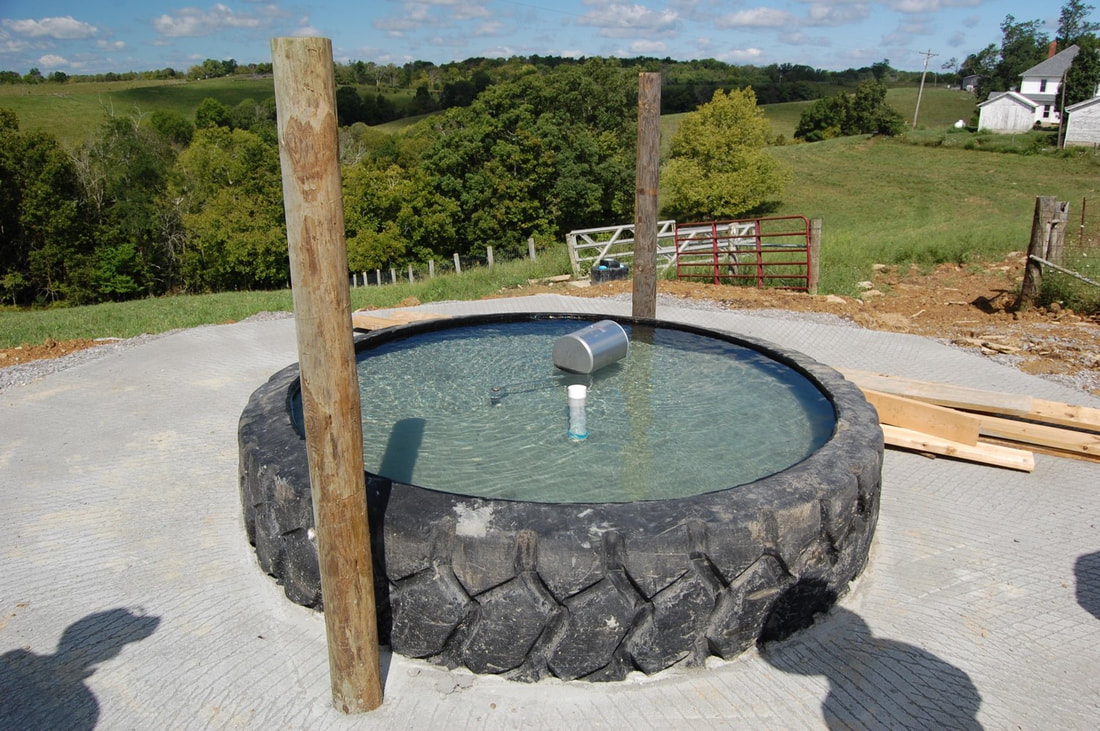|
Due to the current extreme cold that we have been experiencing in Kentucky for the past several weeks I have received a lot of questions as to how the tire water tanks are performing. First of all, YES, the tire water tanks do freeze. If someone tells you the tires do not freeze they are probably trying to sell you a tire water tank. Having said that, the tires do freeze less that a traditional concrete or plastic water tank. The rubber is about 6-8 inches thick and acts as an insulator. The tires also hold a large volume of water which takes longer to cool down and therefore is slower to form ice. You may also recall that we have used a product at the farm called shade balls. These are softball size plastic balls that are half filled with water so that they float about half submerged on the surface of the water. We use the shade balls to shade the water in the summer to keep the water cooler and prevent algae growth in the tanks. They work extremely well for this purpose. The entire surface of the tire is covered with shade balls and the cows simply push them down and out of the way to get a drink of water. The first winter we experimented with using the shade balls during cold weather. We ended up with mixed reviews. The shade balls did help keep the tanks from freezing a little bit. They cut down on the surface area of the exposed water and served as protection from the wind. They seemed to help prevent freezing with temperatures getting down into the low 20's. If the tank did form a little bit of ice the shade balls helped to thaw the ice if the sun came out at all. The black balls absorbed the solar radiation and the tanks thawed out before the temps rose 32 degrees. Below are pictures of the same tire tank with a small amount of ice around the shade balls. If you look close around each shade ball you can see it is beginning to thaw the ice. The black balls are absorbing the sunlight and transferring that solar energy to the ice to cause it to begin thawing. As the temperature drops below 20 degrees the shade balls begin to get in the way. As the ice gets thicker the balls are not enough to thaw the ice anymore. At that point we have to chop the ice from the tire, and the shade balls are in the way to do so. So we now remove the shade balls from the tanks once temperatures start to dip into the teens. In the extreme cold weather that we have had recently the tires are freezing each day. We chop the ice off to give the cattle access to water, but by the next day the ice has to be removed again. The picture below is of the tire waterer at the calving barn. This tank has 13 head of mature cows using it. The night before the temperature was down to 0 and the night before that was recorded at -6. As you can see the tank had about two inches of ice on it. The next tank is at the bull barn and has 30 replacement heifers on it. This tank had approximately the same amount of ice as the first one at roughly 2 inches. The spring that we developed last summer has been working well. It is set up so that the water from the spring flows continually into the tire tank and then out the overflow at the top and back to the creek. The continual flow of this tire tank has kept it from freezing completely. We have not removed the ice from this tank all winter. As you can see in the pictures the ice is of varying thicknesses and is still open where the inlet flow is disturbing the surface of the water and around the outlet pipe where water is moving. Although the opening is small, it is still enough that a cow can get a drink of water. This tank shows that it doesn't take much of a disturbance to keep the ice from forming on the surface. We are currently working with Dr. Higgins at University of Kentucky to demonstrate options for keeping the tire tanks thawed during the winter. I will keep the blog updated with what works and what doesn't as we progress forward. For now, stay safe out there as you tend to your livestock during this harsh time of year.
|
Archives
June 2024
Categories
All
Welcome |
CONTACT US |
EMAIL SIGN UP |
|
Eden Shale Farm
245 Eden Shale Rd. Office: (859) 278-0899 Owenton, KY 40359 Fax: (859) 260-2060 © 2021 Kentucky Beef Network, LLC.. All rights reserved.
|
Receive our blog updates
|
















 RSS Feed
RSS Feed
